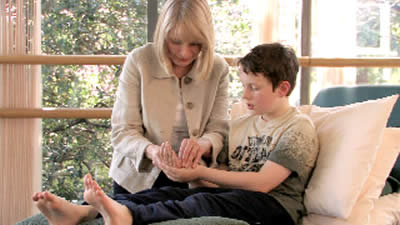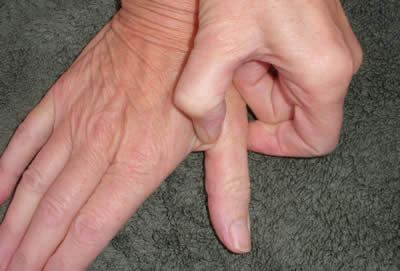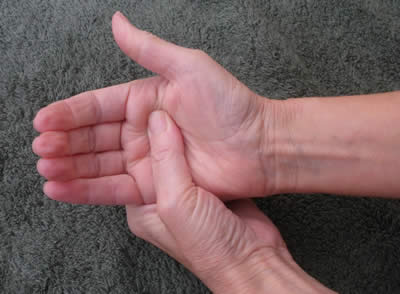Positive Health Online
Your Country

Self-Help Reflexology - Empowerment for Holistic Health
listed in reflexology, originally published in issue 191 - February 2012

A Child Learns Reflexology Rocking Technique to Help Sleep Patterns
Reflexology is one of the more accommodating therapies when it comes to self-help techniques. Osteopaths and masseuses, for example, are often unable to minister to their own needs very well and have to rely on other colleagues to treat them. In the case of reflexology, a person can easily access their hands and feet and work them very effectively. Reflexologists can teach their clients, family and friends basic self-help reflexology techniques with good results between treatments. One does not have to be a qualified therapist to benefit from the simple self-help instructions that can be found in many reflexology books. Hand reflexology has often, mistakenly, been considered a less effective form of reflexology. This is not correct, although the sensation or responses from the hand reflexes are slightly delayed and may take a few seconds longer to be experienced. Secondly, the hands are not only far more accessible, no garments need removing and it is very much easier for a person to work their own hands than their feet (which is impossible for those with mobility issues).
Qualified Reflexologists often comment that, when they work their own feet, they obtain reasonable results but cannot feel much sensitivity. Vertical Reflex Therapy (VRT), where the weight-bearing hands or feet are briefly worked for a few minutes, can give a quick added dimension to treating personal ailments quickly and effectively as the reflexes become more sensitive and responsive. I teach postgraduate VRT / Reflexology classes and always encourage the therapists to give their clients homework in the form of 3 or 4 precise instructions regarding working on their own hands or feet: twice a day for two or three minutes, especially if they are in a weight-bearing position. A few simple reflexology techniques working on the pressure points of the hands is often easy to apply and the results may be very positive in maintaining mobility in a limb, for example.
Quick Self-Help Applications

Working Base of Thumb for Headaches
A Reflexologist might treat a client for a full hour using foot reflexology only, but can show the person how to work their own hands, for only 1-2 minutes, to help a neck pain by pressing and pinching round the base of their thumbs.
.jpg)
Working First Thumb Joint for Headaches
If someone is suffering from a headache they can work the first thumb joint on both hands - below the nail which may ease a throbbing sensation

Reflexology Diaphragm Rocking technique
One of the most effective reflexology treatments for sleep is Diaphragm Rocking which is a technique I devised for the passive feet or hands. Anyone, from small children to older people, can be taught to gently and rhythmically rock their hands, one by one, backwards and forwards with their thumb pressing on their palm. The pressure is on the diaphragm, chest and lung reflexes and appears to relax the person and helps to reset their body clock. Gentle pressure on the adrenal reflex, situated on the thenar muscle on the palm, may help to boost energy or reduce the level of stress.
.jpg)
Working the Adrenal Reflex
Self-help and Reflexology in the Workplace
In 2002 I undertook a small survey to assess whether a 25 minute hand and foot reflexology treatment could produce an positive outcome for employees who had suffered from a variety of conditions ranging from pain and mobility issues to chronic eczema in the ear. Six persons from a large company were invited to take part in this small survey comprising 4 weekly reflexology sessions. None had received reflexology before, and in each case there was a positive response to the treatment within the first 1-2 weeks; after 4 weeks some conditions had improved by well over 90% even though some of the problems were long standing and had resulted in time off work.
Each person's treatment session began with 3 -4 minutes of basic Vertical Reflex Therapy on the feet and the hands, then their feet were treated with conventional foot reflexology. Their treatments culminated in a period of concentrated hand reflexology plus tuition on which reflexes to work themselves. One female member of staff, who had been in a bad car accident, received only hand reflexology as she could not bear her feet to be touched and she was one of the employees who improved the most. Each employee kept a record of their reaction/ improvement to each treatment and was given a Hand Reflexology Chart marked with specific reflexes to treat with self-help hand reflexology twice a day for a few minutes between the weekly treatments. After four treatments both the client and myself made an evaluation as to the progress made since the survey commenced. My own conclusion was that the good results were obtained partly due the daily self-help hand reflexology which was a constant trigger on specific reflexes which helped the body to heal itself.
Reflexology Techniques to Support the Musculo-skeletal System
In the short workplace survey, an administration manager in her late 40s, client CM, felt she was over-treating herself at first by working her hands twice daily for a few minutes as she was aching more, not less, in the first few days. She had suffered from intermittent back, hip and neck problems for years, had a demanding job and, at times of stress, she could feel muscular tension throughout her body. She was highly sensitive to all forms of therapy, conventional and complementary, but was so impressed with the way she felt after her first reflexology session that she had no intention of stopping the programme. She deduced that the self-help twice per day was too intense, so stopped and the pain ceased. Her back and hips gradually felt better than they had done for a years and she re-introduced a single short hand treatment every other day.
CM's neck problems flared up one weekend but the reflexology treatment eliminated them almost immediately. Her osteopath was so impressed with the improvement in her back that it was suggested that she extended the time between her regular osteopathic treatments for the first time ever. It is interesting that I chose not to treat any of her conditions specifically in the first two sessions, but aimed to simply balance the body by helping the musculo-skeletal system to adjust. Once there was a general positive response throughout her body, it was possible to precisely help her hips, neck and shoulders to respond quickly and naturally.
Never Limit the Power of Self-help for Older People
Showing clients how to use reflexology for self-help can be very empowering, especially when a person has chronic pain issues. Many begin by helping to manage their condition by introducing some daily self-help reflexology, and then start looking at other ways to improve their health. Mrs LK was in her early 80s when she came to me for reflexology. She was overweight, with high blood pressure and swollen ankles. She was also very sceptical as to how reflexology could help her chronic condition. She is always willing try self-help reflexology on her hands and took her health seriously once she realized that the older body is capable of a positive response. She reported, "Within three months of fortnightly reflexology treatments my blood pressure was back to normal, my ankles less swollen and I felt mobile and energetic. The reflexology sessions inspired me to take responsibility for my own health. I have also started taking nutritional supplements, given up coffee and drink more water. I went to the gym for gentle exercise and started driving and gardening again." Now at 96 Mrs LK is less mobile than she was, but is still living in her own home, driving and doing her own shopping. An exceptional and inspiring case.
References
Books
1. Booth, Lynne. Vertical Reflexology for Hands. Publ Piatkus Books, London. ISBN: 0-7499-2319-9. 2003.
2. Booth Lynne. Reflexology in the Workplace - a small observational study on hand and foot reflexology and VRT. June 2002.
Comments:
-
Cathy said..
Very interesting reading, but please can you tell me the contraindications of having both reflex and an osteopathy treatment in the same day please, thank you Cathy
-
Linda Gauthier said..
I am a firm believer in reflex. and I am going to order your book. I'm 80 years of age and active, but I am very interested in staying active and would like to do more reading on the subject.
67U